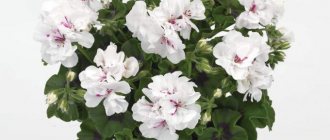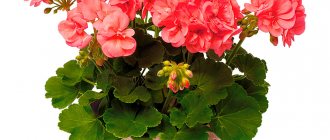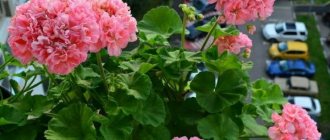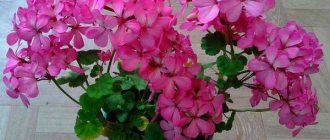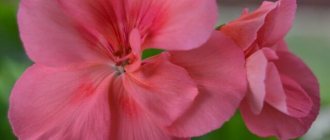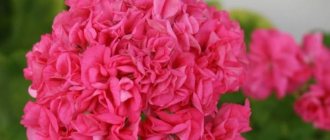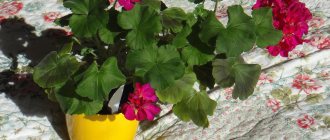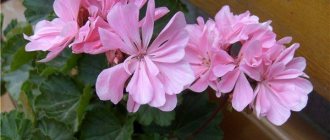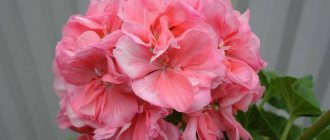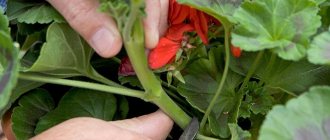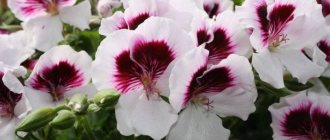Where and how to plant it?
Lighting and location
If a gardener wants his pet to please the eye with its flowering for a long period, it is necessary to place the pot with the plant in a well-lit place.
The flower does not like shadow. A window sill with windows facing south or southeast is perfect. But, it should be remembered that on too hot days, when the scorching rays of the sun penetrate the atmosphere, pelargonium should be shaded. This can be done using a piece of fabric or translucent paper. Decorative flowering cannot be achieved if there is not enough sunlight.
Important! When Clara feels a lack of lighting, the color of its leaves fades, and the plant itself loses its decorative appearance. In addition, the stems stretch, which also affects the beauty
In winter, you need to take care of additional light. You can use a special lamp.
Soil requirements
The flower has no special requirements for soil. More important than the soil is the drainage layer. There must be a layer of expanded clay at the bottom of the pot. Pelargonium has a negative attitude towards waterlogging. The delicate root system can easily rot in such conditions. The optimal soil for Clara Sun is neutral or slightly acidic. It is recommended to add ash to acidic soil.
Substrate composition:
- 1 part leaf soil;
- 1 part sand;
- peat and turf also 1 part each.
If the soil is not particularly nutritious, humus is added to it. In flower shops you can purchase ready-made soil, which is designed specifically for pelargonium.
This is interesting: When to transplant hydrangea from one place to another: we tell you in detail
Appearance
So what is it - zonal geranium?
This is a creature rich in appearance. It is a bush that grows upright with fluffy foliage. The top of the bush is decorated with bright small flowers. Most often they are red, white and pink in color. Geranium has a characteristic smell. And it’s not the flowers that smell, but the leaves. Before purchasing such a flower, smell it. Not everyone likes its smell.
Indoor geranium reaches a height of up to 90 cm . This is a perennial plant. At the same time, it needs to be renewed, since the leaves fall out from below and the bare stems do not have an entirely aesthetic appearance. Grows quickly - up to 30 cm in 12 months.
Varietal pelargoniums photo
Pelargonium sutarves klara san
Without registration using:
- ads
- Animals, plants Animals, plants
- Lost and found
- Business offers
- Childen's goods
- House, construction, renovation
- Beauty, health
- Furniture
- Education
- Clothes, shoes
- Part time job
- Holidays, weddings
- Sports, tourism, hobbies
- Help Wanted
- Services
- Electronics and household appliances
Plants, flowers
- Plants, flowers
Aquariums Accessories Rodents Other animals Food and supplements Kittens and cats Other Birds Beekeeping Fish, aquarium animals Farm animals Dogs and puppies Animal services Ferrets
Varietal pelargoniums
I will sell cuttings of varietal pelargoniums (availability as of October 6, 2020): April Snow 250 Boniface Butterfly 250 Botans Röda 300 Brookside Fiesta 250 Brookside Katerina 350 Deacon Constancy 200 Edwards Jouce 250 Elnaryds Gusten 400 Flaming Kate 250 Free Cerise Polina 300 Gos Brook Ryan David 300 Grainger's Antique Rose 500 Julie 250 Midori Buke (adult) Mimi 250 Mormor Marta 350 Natalie 250 Norrand red sport 300 Norranges Sophie 300 Odensjo Madam Bovary 300 Odensjo Milk and Honey 300 Orion 300 PAC Viva Carolina 300 Royal Norfolk 300 Rushmoor Amur 1000 Rushmoor Platinum An niversary 250 Saxdalence Selma 300 Selma 250 Vina 250 (adult) IV-Pavstushka 400 IV-Sonya Tender 400 IRIOL-Shimmer 400 Leona Drops 500 Silk Alchemist 500 Silk Laguna 300 Yu_Jiga 300 Yu_Kathak 400 Yu_Pink Snow (cactus type) 800 Yu_Snoa 300 Yu_Tsy ganochka 500 Yug-Eva 500
Potted bushes: Malins Parla 100 Millfield Gem 150
We grow beautiful things with our own hands! Pelargonium Denise: photos and care features
Emma fran bengtsbo pelargonium
As mentioned above, Denise pelargonium is one of the most beloved plants by gardeners. Some of them call this variety Denis. On thematic forums there are literally queues for cuttings of this flower: flower growers are ready to shell out considerable sums for the shoot.
The plant belongs to the zonal rosebud varieties, therefore it has all the advantages of pelargoniums similar to roses. Among all rosebud pelargoniums, Denise is considered the most spectacular and most perfect flower.
The plant is not tall, unlike other rosebud species, but the bush still needs to be formed
Note that pruning in this case must be carried out carefully, since Denise is not very fond of this procedure. Who is the creator of this variety is still not known for certain
In addition, sellers of cuttings often sell other rosebud varieties for Denise, only externally similar to this variety. Therefore, it is best to purchase a plant from a nursery - this way there is less chance of running into a “fake” Denise
Who is the creator of this variety is still unknown for certain. In addition, sellers of cuttings often sell other rosebud varieties for Denise, only externally similar to this variety. Therefore, it is best to purchase a plant from a nursery - this way there is less chance of running into a “fake” Denise.
Plant propagation
Denis pelargonium reproduces in the same way as all its “neighbors” pelargonium: by seed and cuttings. When planting seeds, there is no guarantee that the plant will inherit all the characteristics and characteristics of the variety.
For this reason, rosebud pelargoniums are propagated exclusively by cuttings. Beginning flower growers often complain about rotting of planted cuttings. It is very disappointing when, with such difficulty, a cutting of your cherished dream - the beautiful Denizka - is acquired, but the efforts made do not bring the desired results, and the plant does not take root.
To avoid such disappointment, you can use the following recommendations:
- The optimal time for plant rooting occurs in March and lasts until July.
- Cuttings are taken from an adult plant. To do this, a cutting with 3-5 pairs of leaves is cut from a semi-lignified shoot. If you take a green grassy shoot, you won’t get a full-fledged cutting from it.
- The soil mixture for germinating a plant should be light and breathable, for example, peat + soil soil or coconut filler, the main thing is that the soil is neutral in acidity.
- The cuttings are dried on paper in the open air for one to two hours, the lower leaves are removed and planted in the ground, slightly buried in the ground.
- The planted cuttings are carefully watered, trying not to create excessive humidity.
- Water for irrigation is pre-settled for several hours at room temperature.
- Place the container with cuttings for rooting in a bright, well-lit room, for example, on a windowsill. In approximately half a month, the cuttings will acquire their first thin roots.
- As the flower grows, it is periodically fed with potassium-phosphorus complex fertilizers.
- In winter, the plant loses its decorative effect a little and practically does not bloom. Therefore, it is best to leave the rosebud dormant until spring, rarely water it and not apply any fertilizer. The recommended winter temperature for Denizok is only +10-15 degrees.
On a note. At the end of February, the pelargonium plant is moved to a warmer room, fed, and soon the bush begins to actively develop and by mid-summer pleases with its first buds.
Watering and spraying
The plant does not need spraying. The watering regime should be such that the substrate is constantly moist, but without stagnation of liquid in the roots. Watering is needed frequently and not abundantly.
Landing
Pelargonium ingrid
Let's find out the requirements of this plant for its habitat, soil, and lighting.
Location and lighting
In order for Pelargonium Clara to delight you with its flowering for a long time, you need to place its pot in a bright place. Like all geraniums, this plant does not like shade. If Clara does not have enough light, decorative flowering will not work: there will be few inflorescences, and those that appear will not be large in size.
If this measure is not taken into account, the flowering period will decrease, and the buds themselves will become much less lush and decorative. In addition, with a lack of light, Clara’s stems stretch and the foliage turns pale. This also negatively affects the beauty of the plant.
The soil
As for the composition of the soil, in this regard Pelargonium Clara is not particularly demanding.
Much more important for the plant is good drainage. Don't forget to put a layer of expanded clay on the bottom of the pot. Geranium does not tolerate waterlogged soil. Its delicate roots can easily rot in such conditions. Pelargonium Clara Sun will feel best in soil with either a neutral or slightly acidic reaction.
Experienced gardeners add ash to the soil if it is too acidic. Recommended substrate composition:
- leaf soil - 1 part;
- turf - 1 part;
- peat - 1 part;
- sand - 1 part.
If the soil is not very nutritious, you can also add humus. You can buy a ready-made substrate for geraniums in the store - in this case it will be optimal.
Let's get acquainted with the main points for caring for this ornamental plant.
Watering
Regular soil moisture is very important for Clara pelargonium. Although watering should be quite abundant, it is also important to avoid waterlogging the soil. Otherwise, the roots of the plant may begin to rot.
Therefore, water only when the top layer of the substrate dries out.
Otherwise, the roots of the plant may begin to rot. Therefore, water only when the top layer of the substrate dries.
If there is a need to humidify the air, then this must be done using a spray bottle, directing the stream to the area around the pot, and not to the plant itself.
Feeding
The plant needs additional nutrition. Clara responds to proper application of the necessary fertilizers with longer and more luxuriant flowering. In spring, the plant needs nitrogen compounds, and when the inflorescences begin to form, it is better to focus on potassium-phosphorus complexes. In the store you can purchase a complex mineral composition for pelargoniums. It will fit optimally in this case.
It is important to know that pelargonium does not like organic fertilizing. It is also important not to exceed the dose of fertilizer prescribed in the instructions. If you overuse fertilizing, the roots of pelargonium may well get a chemical burn.
The frequency of fertilizing during the growing season is twice a month; in winter, the plant does not need additional nutrition.
If you overuse fertilizing, the roots of pelargonium may well get a chemical burn. The frequency of fertilizing during the growing season is twice a month; in winter, the plant does not need additional nutrition.
Trimming
Only competent and timely pruning can give the pelargonium bush the correct compact shape and protect the plant from elongated, ugly shoots. Let us note that it was the inability to properly trim a flower that at one time was the reason for the loss of popularity among pelargoniums among flower growers. To form a compact and lush bush, you need to regularly pinch the apical parts of young shoots. This measure will allow the plant to grow wider and form a larger number of flower stalks.
As a rule, shoots of young plants are pinched after four to five pairs of leaves appear on them. The most suitable time for pruning is the spring months. And if pinching is used for young shoots, then pruning is used for adult plants.
The plant requires special attention in the first year of its life. During this period, it is necessary to spend the maximum amount of effort to form the correct shape of the bush. But in the second and subsequent years you can relax: the formed bush will require only “cosmetic” pruning.
Beneficial features
It has long been known that zonal pelargonium has beneficial properties:
- The essential oil of this plant is used in herbal medicine. It helps with neuroses, cardiovascular diseases, insomnia and hypertension.
- The foliage has antimicrobial properties.
- The bush helps purify the air in the room.
- The essential oil obtained from this plant is used in the cosmetics industry.
Pelargonium zonal care in November cuttings
Further care
Sutarve Clara Sun is unpretentious, but it is still necessary to follow the basic rules for caring for flowers so that they please gardeners with their appearance and long flowering.
To prevent the plant from stretching out, it is provided with an optimal light regime and shaded. To form a crown, a beautiful, even shape of the bush, periodically turn the pot. This way the branches and leaves are stretched evenly.
Water, observing the temperature regime. Feed and prune in a timely manner. If you follow the rules of care, Sutarve Clara San will constantly bloom and have a well-groomed appearance.
Temperature
Flowers should grow in a warm place. Comfortable temperature is from +14 to +27 °C in summer. This variety of pelargonium loves fresh air (not drafts), so the room is periodically ventilated. If the air in the apartment is dry, the tips of the leaves of the bushes dry out.
The plant does not tolerate temperatures below +12 °C - its growth and development slows down. Later it dies from hypothermia.
Watering and spraying
Pelargonium Sutarve Clara Sun is properly watered and sprayed if necessary. The plant does not tolerate either drying out or excessive moisture. Watering is carried out as the top layer of soil in the pot dries. If the earthen ball is constantly wet, then the roots of the flower begin to rot. In time he will die. Pelargoniums Sutarve Clara San can accumulate moisture and go without water for some time. Watering frequency is once every 1-3 days, less often in winter.
To prevent the leaves of the bush from drying out, spray them with a spray bottle with a fine spray nozzle. During the procedure, make sure that excess water does not collect in the rosettes of leaves - this harms the plant. In winter, spraying is not required. Sutarve Clara San, under optimal external conditions, does not require abundant watering and spraying.
Loosening
Sutarve Clara San grows normally in aerated soil, so it is periodically loosened in pots. If you do this after every watering, it will save you from fungal diseases.
Loosening is carried out carefully, penetrating the tool shallowly, without damaging the root system of Pelargonium Sutarve Clara San
Feeding
For abundant flowering, fertilizing is carried out regularly. Do not fertilize bushes only in winter, when they rest. For feeding, ready-made liquid fertilizers and universal compositions for flowers are used. It is better not to saturate Sutarve Clara Sun with organic fertilizers.
| Month | What to do |
| January | No fertilizing is carried out, the plant is resting |
| February | |
| March | Fertilize with fertilizer with a high phosphorus content |
| April | |
| May | Apply fertilizers with a high potassium content |
| June | |
| July | |
| August | |
| September | |
| October | |
| September | Fertilize with fertilizer with a high phosphorus content |
| December | No fertilizing is carried out, the plant is resting |
For continuous year-round flowering of indoor Sutarve Clara San, they are fed with magnesium sulfate. After applying fertilizer, the plant intensively grows buds and constantly blooms. Magnesium sulfate is stirred at the rate of 5 g per 5 liters of warm water. Water carefully, under the root.
Trimming
Constant pruning stimulates crown growth. It is not advisable to do this with scissors, because this will damage the flower branches. Cut the shoot at an acute angle using a utility knife or blade. The cut area is sprinkled with a powdered activated carbon tablet. Pruning is carried out at the end of February.
The tops and excess young shoots are carefully pinched without damaging the stem.
Possible problems
Domestic zonal pelargonium most often becomes ill due to contaminated soil or due to improper care. Most often, flower growers face problems such as:
- There are white circles on the leaf blades . The plant is affected by rust. The development of this disease is promoted by excessively high humidity and heat.
- There are spots with gray fluff on the stems and undersides of leaves . Gray mold has developed due to stagnation of moisture in the substrate.
- The foliage changes its color to red . The room is very cold or the air humidity is extremely low.
- The lower leaf blades turn yellow and brown spots form on them . Too infrequent or poor watering.
- Rot appears on the stem at the substrate level . Water systematically stagnates in the soil mixture.
- The stem turns black . The bush is affected by the “black leg”. The plant is affected by this disease due to an infected soil mixture or due to excessively high substrate humidity.
- Lack of flowering . Excessively poor lighting, either the substrate contains a lot of nutrients, or the bush overwintered in a very warm place.
- There are yellow spots on the foliage . Sunburns.
- The tops of the leaf blades turn brown . Very low air humidity.
- The foliage at the bottom of the stem dies. This is a completely natural process associated with the growth of the bush.
- The edges of the leaf blades have turned yellow. The plant is standing next to a working heating device, has been exposed to a draft or a sudden change in temperature.
- Pests. Most often, spider mites, aphids, whiteflies and mealybugs settle on the flower.
Description of pelargonium Sutarves Klara San (Sutarve Clara San) and care for it
A stunningly beautiful plant with soft pink lush flowers, pelargonium Sutarve Clara San, is often grown in summer cottages, in rockeries, next to alpine hills. An unpretentious plant to care for, it belongs to the group of zonal pelargoniums.
Description of the variety
Pelargonium Sutarves Klara San was selected in 2022. It has double flowers that are highly decorative; due to the small number of petals, the bud does not open completely.
Pelargonium Sutarve Clara San - an ideal plant for true romantics
Features of the variety:
- The inflorescences are shaped like roses. The petals are pink, the middle is light green. Diameter - 3 cm.
- The buds are collected in inflorescences.
- The leaves are large, rich green in color. Each rounded leaf rests on its own long stem.
- Flowering continues from March to early November.
- Fast growth rate, within a year the plant develops into an adult shrub.
Note! The more light there is in the place where pelargonium or geranium is planted, the brighter and more saturated the pink petals will be.
Similar varieties
Pelargonium Clara Sun is similar to some other decorative varieties related to geraniums.
Pelargonium Odensjo Symfonia - description
This is another zonal pelargonium. Anna Sun is a bush up to 35 cm high, but very neat. Terry soft peach flowers are collected in a decorative inflorescence.
A distinctive feature of the variety is double snow-white flowers with a light pinkish tint. Pelargonium flowers Sutarve Nadya K are up to 3 cm in diameter, collected in inflorescences.
The bush is compact and does not lose its shape even without constant shaping. The leaves are rich green.
This variety of pelargonium is distinguished by elegant speckled petals. Snow-white flowers are decorated with pink edging and specks. The leaves are elegant, bright green.
For reference! There is another similar variety, which by the way does not belong to the Sutarves variety. Such a flower is the Alpenbloss Fischer pelargonium.
Planting and transplanting
Pelargonium Tuscany and its varieties Edwards, Bernd and others
The plant is unpretentious, but it is important to provide it with normal care. For pelargonium to grow and bloom, it is necessary to create optimal conditions for the plant.
For pelargonium to grow and bloom, it is necessary to create optimal conditions for the plant.
Choosing a place and pot
The pelargonium variety Sutarves Klara Sun needs natural light, so place the plant on the south or southeast side.
However, in summer it is important to create openwork shading for the flower to protect it from direct rays of the sun. Suitable pot diameter - approximately 2 cm larger than the crown projection
If you choose a larger container, the plant will spend a lot of energy on developing the root system rather than growing and flowering.
A suitable pot diameter is approximately 2 cm larger than the projection of the crown. If you choose a larger container, the plant will spend a lot of energy on developing the root system, rather than growing and flowering.
Note! The pallor of pelargonium foliage will indicate a lack of light.
Soil selection
Almost any soil is suitable for Sutarve pelargonium, but a drainage layer of crushed brick and expanded clay is important. This is the prevention of waterlogging.
Slightly acidic or neutral soil is suitable. You can prepare the substrate yourself by mixing leaf soil, sand, humus and turf in equal proportions.
Step by step planting process
It looks like this:
The container is filled with drainage and substrate, then moistened. Seeds are placed on the ground at a distance of 4 cm from each other. Carefully deepen by 0.5 cm and sprinkle with earth. Gently moisten with a spray bottle. Wrap the container in plastic wrap to create a greenhouse effect.
After about 10 days, sprouts will appear. After this, the film is removed and the container is placed closer to the light source.
Further care
Pelargonium Dovepoint - description, planting and care
In order for the plant to delight with elegant flowering, it is important to provide it with good care. Pelargonium Clara Sun will be the pride of any gardener
Pelargonium Clara Sun will be the pride of any gardener
Temperature
The optimal temperature for this variety of pelargonium is from +18 to +24 degrees; it is in such conditions that one can expect growth and beautiful flowering.
Watering and spraying, humidity
Pelargonium is afraid of swampy soil, but it is also afraid of excessive dryness. Watering is carried out as the soil dries; it is recommended to spray with a spray bottle every day in the summer, early in the morning. And in autumn, winter and early spring - no more than once a week.
To maintain optimal humidity for the plant, spray the air next to it.
Popular varieties
Thanks to long-term selection work, which has not yet stopped, the gardener can choose different pelargoniums. They differ in size, color and shape of inflorescences.
"Yu jig"
Pelargonium Knight Salmon - description of varieties of the Salmon series
Common standard option. The stem is straight, the plant reaches medium height. The inflorescences are dense, double, and have a delicate coral hue. Pelargonium Yu Jig will delight any lover of indoor plants with its flowering.
Lake
An unpretentious variety, which is distinguished by spherical inflorescences of salmon color, the edges of the petals are slightly lighter. The leaves are rounded with a brown zone. Pelargonium reaches medium size.
Rafaella F1
A compact plant whose height does not exceed 30 cm. Adapted for growing in flower beds, balconies and in rooms.
Double flowers can be colored milky, peach, orange or scarlet.
Important! With proper care it blooms throughout the year.
The variety is quite new and therefore difficult to find on sale. Pelargonium is adapted to different conditions, so it tolerates heat and cold.
Bold Gold
Suitable for growing in open ground and at home. It has abundant flowering, the leaves are light green with a brown ring in the center. The color of the inflorescences includes all shades of pink and red.
Other varieties
Pelargonium Lara Harmony has double flowers of a lilac hue. Large umbrella inflorescences appear from the beginning of spring until the end of autumn. Differs in miniature size. Lara Harmony is a pelargonium with flowers that resemble a rose.
The Minx variety is also characterized by small growth and bright scarlet inflorescences. They stand out especially against the background of dark foliage.
Yu Gamayun pelargonium with unique lilac flowers
Each variety has its own characteristics. You can collect a unique collection of plants, which will differ in inflorescence color and size. For example, pelargonium Silk Swan is compact, has a thick stem, dense leaves, and white flowers.
For reference! It is advisable to compare all the names of the varieties and use only those in Latin. In stores, sellers cannot always correctly identify the type of plant.
Pelargonium Lara Delight is medium in size and the inflorescences are fuchsia with a white center. This variety is not as lush as the others, but it has a beautiful color.
- Pelargonium Lara Delight will appeal to lovers of everything bright and attractive. You can look for varieties with calmer colors. Large plants can become a decoration of the garden.
- Yu Disko is a rare and not so popular pelargonium. Her inflorescences are pale pink and they are collected in small umbrellas. Tall peduncles make spherical flowers noticeable among other plants.
- Pelargonium Yu Princess has a similar color, but the inflorescences are rosebud and with small light shades of pink. Over time, the petals begin to curl into a tube, which gives the plant an unusual appearance.
- Yu Kathak is a pelargonium with an unusual leaf color. There is a brown border on a yellow background. The inflorescences themselves are double and bright red. The variety is large and easily tolerates pruning.
Pelargonium Yu Lilac Mist features pale purple flowers
For reference! In stores you can often find plants of different varieties, but sellers usually do not separate them. You can buy geraniums in different shades in this mix.
Care
Watering
It should be done regularly and with plenty of water.
But, please note, in no case should the soil be allowed to become waterlogged - a natural body formed as a result of the transformation of the surface layers of the Earth's land under the combined influence of soil-forming factors
Accordingly, you need to water the plant when the top layer of soil dries out.
Top dressing
Clara Sun needs extra nutrition. If you apply fertilizer correctly, the princess will thank you with long and lush flowering.
In the spring you need to use nitrogenous fertilizers, during the formation of inflorescences - potassium-phosphorus fertilizers. You cannot apply organic fertilizers to nourish plants and increase soil fertility, as pelargonium will react poorly to them.
During the growing season, the plant should be fed twice, no more. In winter, this should not be done at all.
Trimming
Pruning is necessary so that the plant biological kingdom, one of the main groups of multicellular organisms, including mosses, ferns, horsetails, mosses, gymnosperms and flowering plants, does not suffer from elongated and unsightly shoots.
In order for the Republic (French République togolaise) - a state in West Africa bordering Ghana in the west, Benin in the east and Burkina Faso in the north to form a plant correctly, you need to regularly pinch the upper parts of young shoots Escape (right) - unauthorized leaving of a place imprisonment.
Diseases and pests
In principle, like all other plants, pelargonium Clara female personal name San can be attacked by pests or various diseases.
Common pests are spider mites, whiteflies, and aphids. Fungicides and preparations with permethrin are used as treatments for pelargonium.
In addition, it is very important to follow all the rules of care in order to prevent the occurrence of diseases - this is a condition of the body expressed in the disruption of its normal functioning, life expectancy, and its ability to maintain its homeostasis. Read us at. Read us in
Read us in
Pelargonium ODENCIO MADAME BOVARRY
Compact, neat bush with huge caps of dark red flowers, medium terry.
One of the best varieties.
The flower stalks are driven one by one. Blooms all year round.
BRIGHT FLOWERS WILL PLEASURE YOU IN WINTER EVEN MORE THAN IN THE SEASON - THE FLOWERS ARE NOT TALL AND STRONG, THE FLOWER LASTS FOR A LONGER TIME IN WINTER THAN IN SUMMER.
FLOWER LARGE, DOUBLE, OPEN. THE LEAVES ARE VERY BEAUTIFUL AND VELVET.
I ACCEPT ORDERS FOR ROOTING CUTTINGS, ALSO CHECK AVAILABILITY OF READY CUTTINGS. AVAILABLE FOR SELF-PICKUP PRICE 250 RUR
Price: 300 rub.
- Portfolio
- Photo gallery
- Products and services PELARGONIA COLLECTION BY ELENA STRIZHAKOVA
- IRISES - ELENA STRIZHAKOVA COLLECTION (THERE IS AN OPPORTUNITY TO PURCHASE SEEDLINGS)
- LILY BULBS
- PEONIES HERBS SEEDLINGS
- Strawberry/Strawberry seedlings
- Professional flower seeds retail
- PROFESSIONAL VEGETABLE SEEDS IN MINI PACKAGING
- Professional flower seeds wholesale and small wholesale
- Seedlings (seedlings) from our nursery
- Professional vegetable seeds wholesale
News About us Reviews
- FLOWER TECHNOLOGIES
Planting material (seedlings/seedlings) is grown in open ground, providing a sufficient degree of protection from pests and diseases. Planting material on natural black soil turns out healthy, strong (viable) and alive.
All information on the site is posted in order to provide the buyer with the opportunity to familiarize themselves with the product before purchasing it, and does not constitute a public offer (Article 437 of the Civil Code of the Russian Federation). For availability and cost of goods, please contact Elena Strizhakova by phone.
We will also check availability when accepting an order through the shopping cart.
Sutarves Klara San: brief description of the variety
Pelargonium Sutarves Klara Sun (see photo) at first glance is indistinguishable from Appleblossom Rosebud, which is not at all surprising - this particular variety was used for breeding work. The main difference lies in the different number of petals and buds in the inflorescence - Clara Sun can boast of greater terry and denser, fuller caps.
Pelargonium Sutarve Klara Sun
The average diameter of Sutarves Klara San flowers is 3-3.5 cm, but the variety grows large inflorescences. The color of the petals is quite unusual - the white buds are illuminated by a greenish core, with a pink border along the edge. Its saturation depends on the conditions of its maintenance - if you place the pot on a well-lit windowsill, the flowers “sunbathe” and become brighter, especially when grown in warm conditions. Coolness and lack of light allow you to get a less intense color in a pale version.
Sutarve Klara Sun has a fast growth rate - in just a year you can get a full-fledged bush. The plant tends to bloom at a young age, even with an unformed crown, but produces a large number of inflorescences upon reaching maturity (on average after 2 years). Budding takes a long time, often from spring to mid-autumn.
In order for the crown of Sutarves Klara San to develop harmoniously, the shoots need to be regularly pruned and pinched - this will stimulate the appearance of numerous lateral buds. If not properly cared for, the plant will produce one main shoot, turning into something like a palm tree. The recommended pot volume for adult bushes is approximately 2 liters; it is not advisable to use larger containers, since Clara San will devote all her energy to developing the earthen clod, and not to flowering.
Rules for successful formation of pelargoniums
For pruning, use only clean (treated with alcohol or hydrogen peroxide) and sharp tools.
Pinching shoots should only be done with clean hands so as not to infect the plant.
You need to cut the shoot directly above the leaf so that there is no bare stalk left.
The shoots from the root need to be pinched, then all the energy of the plant will go to the formation of the main stems.
When 3-6 nodes with leaves are formed on young shoots, it is necessary to remove the growing point on them. After this, new shoots will begin to develop from the leaf axils, on which flowers will form in 7-10 weeks.
Shoots affected by the disease must be cut off, including 3 cm of the healthy part of the branch.
All cuts must be treated with brilliant green or crushed charcoal.
After pruning, to speed up the growth of the plant, it is recommended to add nitrogen fertilizer to the soil.
During the flowering period, pelargoniums need to be fed with phosphorus and potassium fertilizers.
By following these simple tips, you can easily grow beautiful pelargonium, full of strength and energy, which will become a real decoration for your home.
Svetlana Ryabova
Reproduction
Many owners of pelargoniums want to get new specimens for their collection. The plant is propagated in two ways - cuttings or seeds. Each has its pros and cons.
Cuttings
The simplest option is that after pruning, the branches are cleared of the lower leaves and placed in water. After this, you just have to wait for the roots to appear.
Some gardeners recommend planting cuttings directly into the ground.
They are buried to a depth of 2-3 cm, after which they are carefully watered. Germination may take several weeks.
Seeds
This method allows you to obtain rare varieties, but it requires a lot of time and special growing skills. Collecting the seeds is simple - you need to wait until dry boxes form in place of the flower stalks. They will contain seeds.
It is better to grow them in spring. To do this, place one seed at a time in small pots and sprinkle with soil. They are covered with a bag or glass on top, which creates a greenhouse effect.
For reference! The first shoots appear in 3-4 weeks. After this, you need to wait for the sprouts to get stronger and transplant them into new pots.
